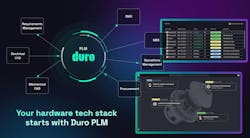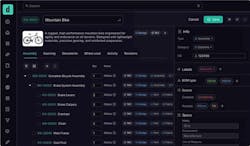From Siloed to Synchronized: A Vision for Agile Hardware Development
The complexity of hardware engineering continues to grow, as does the challenge of maintaining effective communication and integration between design and production teams. Companies want a product lifecycle management (PLM) system that integrates easily with other key systems. Information silos—where departments operate in isolation without shared data—create manual work, slow collaboration and hinder traceability. This can lead to delayed or missed product launches, especially in highly regulated industries like aerospace, defense and medical hardware.
Duro’s Technology Partner Program aims to tackle this issue by establishing a cohesive digital thread that spans the entire product lifecycle by breaking down the knowledge barriers and enabling real-time data access. The company helps design engineers to collaborate more effectively, reduce errors and accelerate time to market.
“Our collaborative model helps customers avoid vendor lock in, eliminate information silos and create a digital thread that supports agile product development and faster delivery,” said Michael Corr, CEO of Duro.
The PLM platform integrates with a range of tools that are used in engineering processes. Through its Open GraphQL API, developers can implement custom integrations that connect Duro with existing technologies such as computer aided design (CAD) and enterprise resource planning (ERP) systems. “For design engineers, this means tighter synchronization between tools like CAD, ERP, MES and sourcing platforms, and a faster way to push and pull data where and when needed,” Corr said. “Engineers don’t have to wait on IT to build connections—they can query exactly what they need, speeding up design decisions and change management.”
AI-Native PLM for Modern Hardware Engineering
Duro, a platform in PLM for hardware engineering, relaunched its flagship product as Duro Design. The coud- and AI-native PLM solution has been rebuilt to enable companies to accelerate product launches by up to three times.
As the PLM market is estimated to reach $46 billion by 2032, it is largely dominated by tools developed in the 1980s. These legacy systems can be rigid and ill-suited for contemporary workflows.
“With Duro Design, we’re enabling hardware teams to transcend the limitations of outdated tools by unifying design, sourcing and manufacturing into one innovative AI-native platform,” Corr said.
Out-of-the-box features include:
- CAD plug-ins for Solidworks, OnShape Altium 365 and NX
- Best-practice new product introduction (NPI) workflows
- Extendable change order and change request workflows
- Integrations with popular platoforms like Netsuite, SAP, ION, Epsilon3 and Boltline.
Real-world, Real-time Examples
The platform facilitates real-time data access by synchronizing design changes, bill of materials (BOMs) and documentation as soon as revisions occur. This real-time access ensures that all teams work with the latest data, which is especially important in regulated industries. The company’s streamlined change order system is designed to improve accountability and traceability, assisting organizations and maintaining compliance.
The platform is reported to have demonstrated an ability to shorten product development timelines. For example, AstroForge leveraged Duro to redesign its space mining vehicle Odin in less than 12 months, Corr says. Similarly, Rapid Robotics centralized its part data using this platform, allowing for quicker iterations and reduced manual processes.
The company uses feedback from its users to inform platform development. “Feedback from electrical, mechanical and systems engineers directly shapes our road map,” Corr said. This responsiveness helps Duro introduce features based on real user needs.
The company promotes collaboration and communication between engineering, sourcing and production teams by creating a paired system of record. Platforms, open API and native integration simplify the connection of third-party systems into a unified workflow. “Duro helps hardware teams eliminate silos by creating a shared system of record,” Corr said.
Corr added: “Customers like AstroForge rely on our integration with Epsilon3 to align engineering and operations around a single source of truth, accelerating design reviews and reducing errors during space missions.” With centralized BOM management, change approvals and real-time status tracking, Corr says that teams don’t need to chase updates across emails or spreadsheets. “Everyone works from the same up-to-date data, improving speed, clarity and collaboration across the product lifecycle.”
To assist partners and users, the company provides onboarding resources, live chat support and a knowledge base. The program also includes co-marketing opportunities and integration support, with the goal of maximizing the effectiveness of the platform for all.
About the Author
Sharon Spielman
Technical Editor, Machine Design
As Machine Design’s technical editor, Sharon Spielman produces content for the brand’s focus audience—design and multidisciplinary engineers. Her beat includes 3D printing/CAD; mechanical and motion systems, with an emphasis on pneumatics and linear motion; automation; robotics; and CNC machining.
Spielman has more than three decades of experience as a writer and editor for a range of B2B brands, including those that cover machine design; electrical design and manufacturing; interconnection technology; food and beverage manufacturing; process heating and cooling; finishing; and package converting.
Email: [email protected]
LinkedIn: @sharonspielman
Facebook: Machine Design
YouTube: @MachineDesign-EBM


